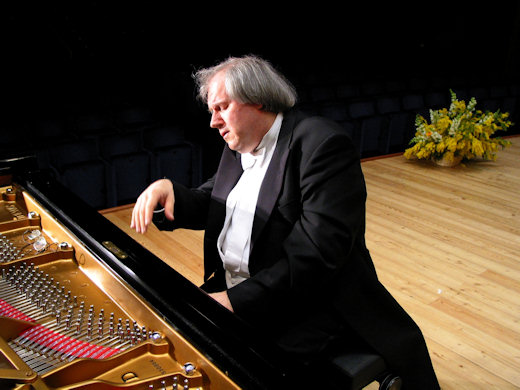Other Links
Editorial Board
- UK Editors
- Roger Jones and John Quinn
Editors for The Americas - Bruce Hodges and Jonathan Spencer Jones
European Editors - Bettina Mara and Jens F Laurson
Assistant Webmaster -Stan Metzger
Founder - Len Mullenger
Google Site Search
SEEN AND HEARD INTERNATIONAL CONCERT REVIEW
Bach, Brahms, Schumann: Grigory Sokolov, piano, Palais des Beaux Arts, Brussels, 7.12.2010 (BM)
J.S. Bach: Partita no. 2 in c minor
(sinfonia – allemande – courante – sarabande – rondeau – capriccio)
Brahms: Fantasien op. 116
(capriccio in d minor – intermezzo in a minor – capriccio in g minor – intermezzo in E major – intermezzo in e minor – intermezzo in E major –capriccio in d minor)
Schumann: Humoreske in B flat major, op. 20
Klavierstücke op. 32 (scherzo – gigue – romanze – fughette)

Grigory Sokolov
Picture Courtesy of Artists
Management Company,
“Grigory Sokolov, a colossus of the piano”, proclaimed the title of the evening’s program notes. This is no exaggeration, and it is a tall order to write about a recital by this exceptional artist, who is doubtless one of the world’s greatest living pianists, not necessarily because he is so renowned – and his fame would be even greater if he indulged in a little self-promotion – but above all because he strongly disapproves of publicity and interviews, or of anything at all that gets in the way of the music itself. So were he ever to read any of this, he would most likely think it was unnecessary at best.
His recital brought together works by three composers who were masters of the keyboard themselves, the pieces ingeniously interlinked in formal and musical terms in ways which did not immediately meet the eye. The partita no. 2 is one of Bach’s suites including sections that are not dances and are referred to (tongue in cheek?) by the composer as ‘Galanterien’, in this case a rondo and a capriccio, the latter standing in for the customary final piece, the gigue, and played by Sokolov with amazing precision, delicately executed ornaments and not without a sense of humor, a quality not associated with Baroque music often enough, although in the case of Bach it is no secret that he was anything but an intellectual highbrow, but rather just as much a romantic at heart as the composers who lived during the era designated as such, and it is safe to say that he would have been delighted to hear his music played on a contemporary pianoforte, especially by a pianist as adept as Sokolov at showing off the qualities of his instrument.
This fairly ‘romantic’ approach to the partita also ensured smooth passage to the next capriccio, the much stormier piece of the same title which marks the beginning of Brahms’ op.116, the first set of late Klavierstücke often referred to as his ‘last will and testament’. The most moving of these are the intermezzi, and here Sokolov’s performance of the e minor intermezzo (andante con grazia ed intimissimo sentimento) stands out, the silences almost more telling than the notes, expressing the emotional depths of the composer’s soul-searching (following the death of his sister and his dear friend Elisabeth von Herzogenberg), which, by all accounts, he went to great lengths to hide behind an uncouth exterior.
Schumann felt this dichotomy very strongly as well, to the extent that he even personified the two opposing aspects of his character by referring to them as Florestan and Eusebius. The two spoke to the audience through the ebb and flow Sokolov lent to the music of his Humoreske, and one has seldom heard a more palpable rendition of that Schumann specialty, the ‘inner voices’ alternating between the thumbs in the middle register in the movement marked ‘hastig’. The Klavierstücke op. 32 are performed relatively rarely, which is a pity since they so plainly contradict the truism that Schumann’s piano music is heavy and complicated (difficult yes, and the composer himself liked to say that he did not write for dilettantes!, but that is another matter.) They could not have been in better hands than those of Sokolov, who conveyed the biting edge of the scherzo and the gigue (the section ‘missing’ from the opening partita) masterfully, as well as the alternating turbulence and tenderness of the romanze, ending in the placid fughette and thus bringing the program full circle with a genre which will forever be associated with the name of J.S. Bach.
Sviatoslav Richter once said that all music was romantic music, and judging by Sokolov’s playing, that might well be his opinion as well. This is no attempt to paint him with a stereotypical ‘Russian School’ brush, though, as his personality is much too unique for that, exuding an endless passion for music in conjunction with a talent for subtlety and understatement – and these are usually well hidden behind an utterly deadpan expression. He never cracked a smile all evening, but went on to play six encores, and one indelible memory of this concert, albeit nowhere near as strong as that of his music-making, will be of the many times he strode back and forth from the wings to center stage and then proceeded to whip his coattails over the piano bench before sitting down at the keyboard yet again.
But the less said, the better, since this is music-making you should experience live (or, barring that, listen to one of Sokolov’s few live recordings – the only kind he is willing to make), not read about. Andrzej Jasiński, pianist and chairman of the jury of the International Chopin Competition, said in a recent interview that in his opinion, to be a good pianist, you have to be a good person. By the same token, Grigory Sokolov is a very extraordinary person indeed.
Bettina Mara
There is an excellent website dedicated to Grigory Sokolov at http://www.rogev.com/sokolov/
